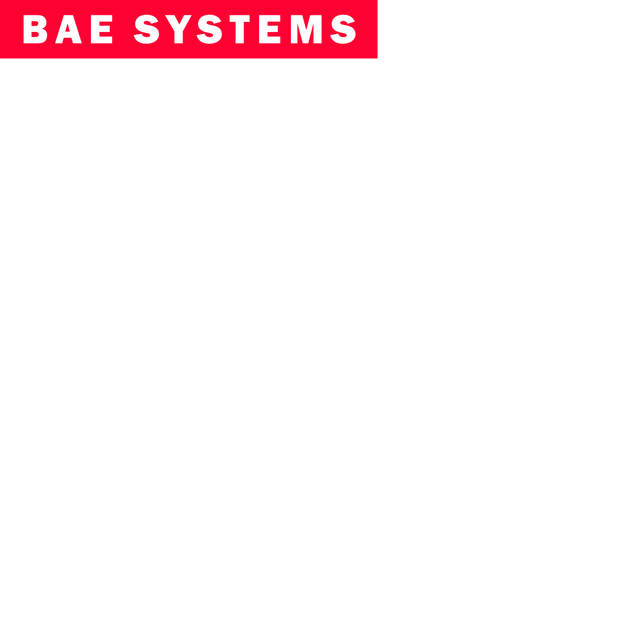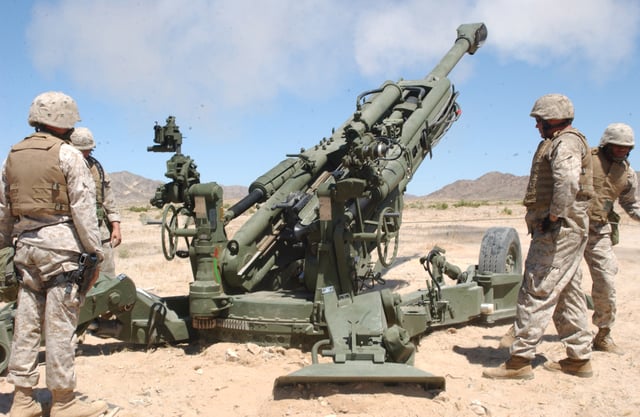BAE Systems Land & Armaments

BAE Systems Land & Armaments

Type | Private (subsidiary of BAE Systems Plc) |
|---|---|
| Industry | Defence |
| Founded | 24 June 2005 |
| Headquarters | Arlington, Virginia, United States |
Key people | Bob Murphy (President) |
| Products | Military vehicles, artillery, naval guns, missile launchers and munitions |
| Revenue | £6.7 billion (2009)[1] |
Number of employees | 19,800 (2009)[1] |
| Parent | BAE Systems Plc |
| Website | www.baesystems.com [14] |
BAE Systems Land & Armaments is a wholly owned subsidiary of BAE Systems Plc. and is responsible for the design, development and production of combat vehicles, ammunition, artillery systems, naval guns and missile launchers. It is the largest such company in the world.[2] It was created on 24 June 2005, following the completion of BAE Systems' acquisition of United Defense in 2004 and its merger with BAE Systems Land Systems. In 2007 BAE Systems acquired Armor Holdings adding to the size of Land & Armaments significantly.
Until April 2003 BAE Systems was a relatively small player in the land systems industry, however following the 2004 purchase of Alvis Vickers, the aforementioned 2004 acquisition of United Defense, and the acquisition of Armor Holdings in 2007 it is now one of the largest land systems defence contractors in the world.
Type | Private (subsidiary of BAE Systems Plc) |
|---|---|
| Industry | Defence |
| Founded | 24 June 2005 |
| Headquarters | Arlington, Virginia, United States |
Key people | Bob Murphy (President) |
| Products | Military vehicles, artillery, naval guns, missile launchers and munitions |
| Revenue | £6.7 billion (2009)[1] |
Number of employees | 19,800 (2009)[1] |
| Parent | BAE Systems Plc |
| Website | www.baesystems.com [14] |
History
BAE Systems was formed in 1999 by the merger of British Aerospace (BAe) and Marconi Electronic Systems (MES). BAe's land systems business was RO Defence, a major manufacturer of explosives, ammunition and small arms. MES owned Vickers Shipbuilding and Engineering Ltd, manufacturer of the M777 howitzer.
On June 4, 2003 BAE Systems outbid General Dynamics for Alvis plc, the UK's principal land systems business. What had seemed a certain win for the US company was stopped by BAE Systems' surprise move. It has been seen as an attempt to keep such a strong competitor at bay in BAE Systems' "backyard." Alvis and BAE RO Defence were merged as BAE Systems Land Systems. When Dick Olver was appointed Chairman of BAE Systems in July 2003 he ordered a review of the company's businesses which confirmed the attractiveness of the land systems sector. This shift in strategy was described as "remarkable" by the Financial Times.[3] On March 7, 2005 BAE Systems announced the $3.174 billion acquisition of United Defense Industries (UDI). UDI, a major competitor to General Dynamics, was primarily a land systems manufacturer, boosting BAE Systems' involvement in this sector and its sales in the important North American market. UDI manufactured combat vehicles, artillery systems, naval guns, missile launchers and precision guided munitions.
BAE Systems Land and Armaments was formed in June 2004 in a reorganisation of BAE's businesses. Land and Armaments, headquartered in the United States as part of BAE Systems Inc., took control of BAE's existing land systems businesses.
Land and Armaments has received regular contracts for the "reset" of Bradley armoured fighting vehicles. By August of the financial year 2006 BAE had received contracts totalling $477.9 million.[4]
In July 2008 BAE failed to win the $1.06 billion MRAP All Terrain Vehicle (M-ATV) contract which will see 7,244 vehicles produced for the US Marine Corps.[5] In September 2009 BAE lost a larger contract, the first stage of a multibillion-dollar follow-on order for up to 23,542 trucks as part of the Family of Medium Tactical Vehicles programme.[6] Despite a successful appeal forcing the US Army to reevaluate the bids, Oshkosh Corporation was confirmed as the winner of the £2.3 billion ($3.7 billion) contract in February 2010.[7][8] BAE announced a £592 million writedown of the former Armor Holdings business as a result.[9]
Organization
Global Tactical Systems
Global Tactical Systems (GTS) was formed from the merger of Mobility & Protection Systems' Medium/Heavy Vehicle business (formerly Armor Holdings) and the BAE Systems Land Systems South Africa businesses.
US Combat Systems
The former United Defense business, BAE's US Combat Systems produces fighting vehicle platforms and armaments.
Global Combat Systems

US Marine gunners test fire a GCS Weapons M777 howitzer.
Global Combat Systems (GCS) was formed on 1 February 2009 by the merger of BAE Systems' Land Systems Weapons & Vehicles, Land Systems (Munitions & Ordnance) Ltd and BAE Systems AB in Sweden. It also has a 50/50 joint venture with Nexter (formerly GIAT), CTA International, which is located in Bourges, France.
GCS Munitions
Sector history
Upon its creation on 2 January 1985, Royal Ordnance plc owned the twelve Royal Ordnance Factories (ROFs) that remained open, plus the Waltham Abbey South site, RSAF Enfield and three Agency Factories. Several factors delayed the intended privatisation until 22 April 1987, when British Aerospace purchased the company.
In 1999 British Aerospace merged with Marconi Electronic Systems, the defence interests of GEC to form BAE Systems. In 2002 Heckler & Koch was sold to Heckler and Koch Beteiligungs GmbH. In 2004 BAE Systems acquired Alvis plc which was merged with the RO Defence business and ex-GEC plants at Barrow-in-Furness and Leicester to form BAE Systems Land Systems. RO Defence was renamed BAE Systems Land Systems (Munitions and Ordnance). In 2005 BAE Systems acquired the US company United Defense and merged it with the Land Systems business to create BAE Systems Land and Armaments. The former RO Defence business was renamed BAE Systems Land Systems Munitions. In February 2009, it was merged into GCS as Global Combat Systems Munitions.
Products
GCS Munitions manufactures 4.6×30mm, 5.56×45mm NATO and 7.62×51mm NATO small arms ammunition, mortars, and land and sea artillery ammunition. It also produces explosives, guidance kits, propellants, demolition charges, initiators, pyrotechnics, and warheads for missiles, torpedoes and depth charges. These include the BROACH multi-stage warhead produced in partnership with Thales Missile Electronics and QinetiQ.[10][11]
GCS Weapons
Manufactures "intelligent ammunition, artillery systems, combat vehicle turrets, naval gun and air defence gun systems." Examples include the M777 howitzer.
GCS Vehicles
Global Combat Systems Vehicles produces and supports main battle tanks, infantry fighting vehicles, armoured engineer vehicles, armoured all-terrain vehicles and military bridging vehicles. Examples include the Challenger 2 main battle tank and the CV90 infantry fighting vehicle family.
Security & Survivability
Security and Survivability (S&S) consists of 3 Functional Areas: Platform Survivability (PS), Individual Protection Systems (IPS) and Advanced Materials. Platform Survivability Product lines include armored, crashworthy, and armored-crashworthy seating for aerospace products along with mineblast attenuating seats for vehicles. IPS produces individual small arms and fragmentation protection solutions, such as ESAPI and XSAPI armor, mostly for military customers. In July 2010, it was announced that Security and Survivability will cease to exist on 1 January 2011. The functional areas of S&S will be assigned to Global Tactical Systems (GTS) or the BAE Systems Products Group.
Management
Bob Murphy was named president of BAE Systems Land & Armaments Operating Group in November 2009 after Linda Hudson was promoted to President and CEO of BAE Systems Inc.
Tom Rabaut was named President of the newly created BAE Systems Land and Armaments, he was previously Chief Executive Officer (CEO) and President of United Defense since January 28, 1994. Rabaut retired on 1 January 2007 and was succeeded by Linda Hudson. Hudson has led General Dynamics Armament and Technical Products and held senior management positions at Lockheed Martin, Martin Marietta, Ford Aerospace, and Harris Corp.[12]